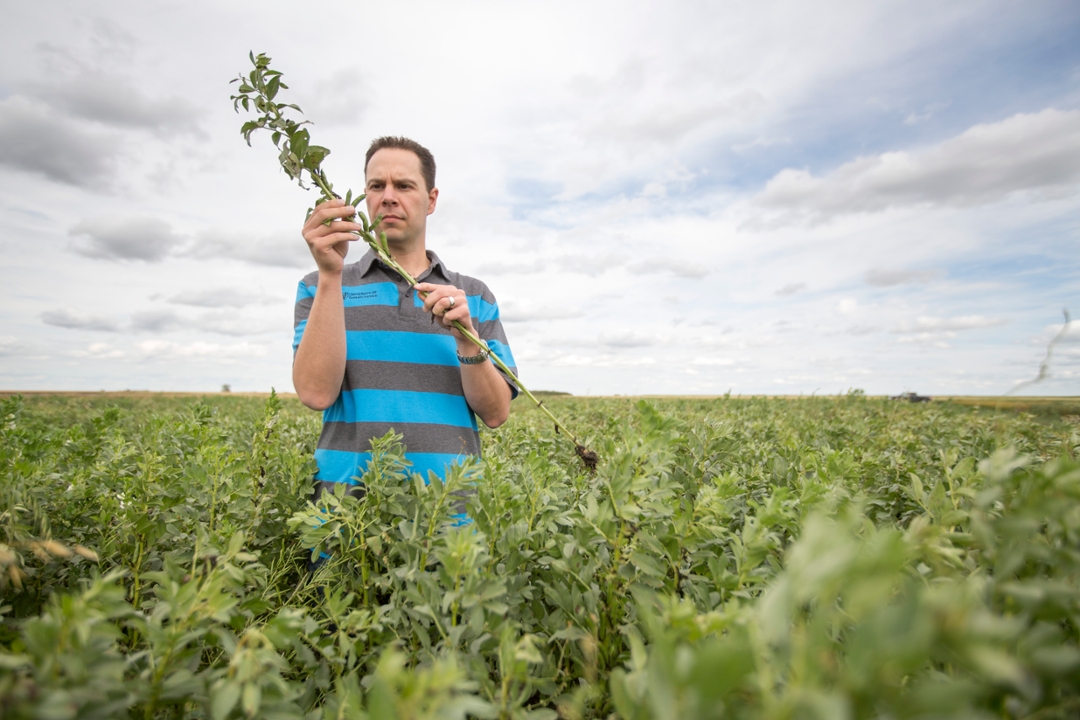
Charting a third way
Forget ideology—tomorrow’s agriculture will be an organic-conventional mash-up.
By Glenn CheaterIn the either/or divide between organic and conventional agriculture, Chris Willenborg refuses to take sides. Or rather, he picks both.
“Too often as growers, and sometimes as scientists, we get stuck in our own ideologies,” said the U of S weed scientist. “When I look to the future when it comes to weed control, I see using approaches from both worlds.”
That future has already arrived in Willenborg’s lab. He points to—with considerable pride—a body of work that includes expanding the range of herbicides for farmers, but also employing approaches such as using bugs and rodents to combat weeds.
Take, for example, his lab’s work on sulfentrazone. It’s one of those hard-to-pronounce chemicals that’s easy to vilify—it kills weeds by bursting cell membranes and persists in the soil for weeks. But it’s not carcinogenic and studies haven’t found toxic effects until you increase exposure to 300 times what you would encounter while spraying.
Willenborg’s research team, in collaboration with industry, proved it was also safe to grow canola a year after applying sulfentrazone, which will potentially allow it to be used more often.
“A fairly significant part of what I do is finding new uses for existing herbicides,” he said. “Herbicides are—by far and away—the most effective form of weed control.”
But before pigeon-holing Willenborg, consider a comment he makes moments later.
“Farmers tend to view pesticides as the first line of defence, but I believe we need to flip that attitude around,” he said. “They should be the last line of defence—a tool you use to deal with those weeds that haven’t been taken out by other management practices.
And for Willenborg that starts with the weed seedbank—the countless millions of seeds that lie dormant on every field, waiting for the right conditions before germinating and starting a new cycle of infestation.
“It’s increasingly being recognized on a global basis that it all starts with the shedding of weed seeds,” he said. “I use the old saying ‘One year seeding is seven years weeding’ to remind people that weed seeds can lie dormant for years and if you don’t deal with them now, you’ll have to do something about them later.”
And one of the things you can do comes straight out of the Mother Earth handbook—work with nature.
“There are a lot of seed predators: song birds; rodents such as voles and mice; and also insects,” he said. “We don’t usually think about invertebrates, but they are the greatest consumers of weed seeds. Although it’s really hard to get real-world estimates of how much insects consume, some U.S. studies have found they can consume 40 per cent to as much as 80 per cent of the weed seedbank for certain weeds.”
One of Willenborg’s grad students has zeroed in on carabid beetles, a voracious but little-known bug, which is highly effective at gobbling up seeds of common weeds such as volunteer canola and stinkweed.
But once again, Willenborg’s research efforts transcend the dividing line between organic and conventional. Another way to manage the weed seedbank is to spray herbicides on crops just prior to harvest. Conventional farmers use this process, called desiccation or harvest aids, because it causes crops to ripen evenly and earlier. But the herbicides are also taken up by weeds that ‘escaped’ previous control efforts, and some herbicides can affect the viability of the seeds they are about to shed.
However, more spraying can also mean fewer insects. Then again, if you also grow cover crops—another favourite in the organic farming toolkit—it tends to significantly boost carabid numbers.
His approach, in short, is a mash-up—using both organic and conventional practices to build hybrid systems. It’s all driven by a pragmatism acquired on his grandfather’s farm in Wakaw, Sask. Save for when he was getting his doctorate, Willenborg spent every spring and fall that he could on the farm helping sow and harvest the crops.
So he views all of his work through “the farmer’s lens”—the tight windows for getting the job done and the even tighter economic margins. But he also looks at the rise of herbicide-resistant weeds—there are now more than 60 in Canada alone—and sees that a new approach is needed.
He’s not alone. Earlier this year, Saskatchewan Pulse Growers donated $2 million to his weed science program, praising both his work on herbicides and his efforts to develop a “robust strategy for long-term weed management.”
“There’s a growing number of people who are realizing we can blend the philosophies of organic and conventional,” he said. “We can draw from both systems, and that’s where the real long-term sustainability of agriculture lies.”

